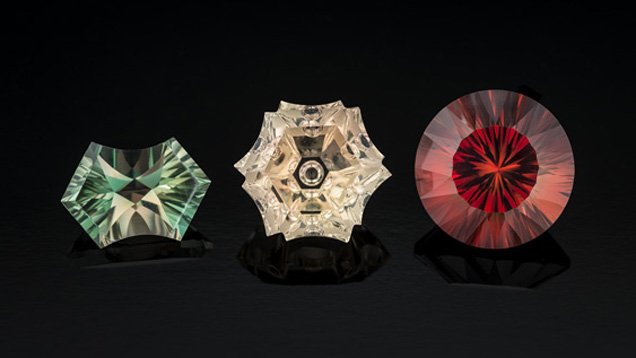Three Occurrences of Oregon Sunstone

Oregon sunstone, the official state gemstone since 1987, is natural copper-bearing labradorite feldspar. Some examples exhibit red to green dichroism, and fine specimens (figure 2) larger than 5 ct can sell for more than $1,000 per carat.
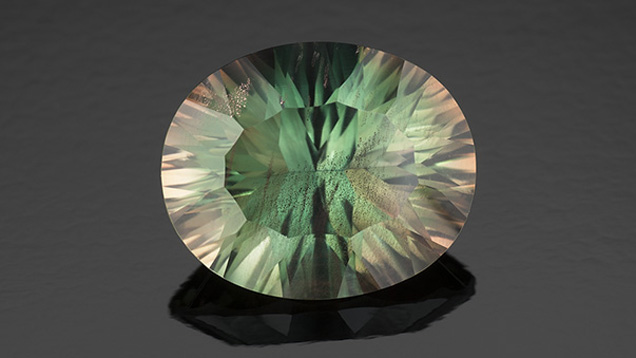
Trip Objectives
This paper incorporates trip findings and previous GIA research to provide a comparative analysis of the gem materials and their geological context and history. We also hope to initiate research that will answer some open questions:- Are all the eastern Oregon sunstone occurrences the same age?
- How do sunstone occurrences correlate with the local geology?
- How did the very uneven color distribution develop in fractured crystals?
- Are sunstones from each of the three mines distinguishable?
In 2006, GIA collected gems from the Ponderosa and Dust Devil mines to characterize natural Oregon sunstone and help distinguish it from treated material (McClure, 2009). For the present study, we collected representative suites of gem materials and rock samples from each mine, documenting the GPS coordinates of each find. By performing argon-argon (40Ar/39Ar) dating on basalt samples and labradorite feldspar crystals from the Ponderosa mine, we hope to confirm the age of its sunstone-bearing basalt and compare that to the Lake County mining locations. We also intend to perform petrographic analyses to characterize the gem-bearing rocks from each deposit and determine their context within the surrounding geology.
We intend to publish the results of these studies in a future G&G feature article and on the GIA website.
Location and Access
Past stratovolcanoes of the High Cascades and across Oregon’s remote High Lava Plains lie three sunstone mines (figure 3). All three produce labradorite feldspar ranging from near-colorless to pale yellow to red and green, including bicolor specimens. The sunstone often contains tiny reflective platelets of native copper, referred to as “schiller.”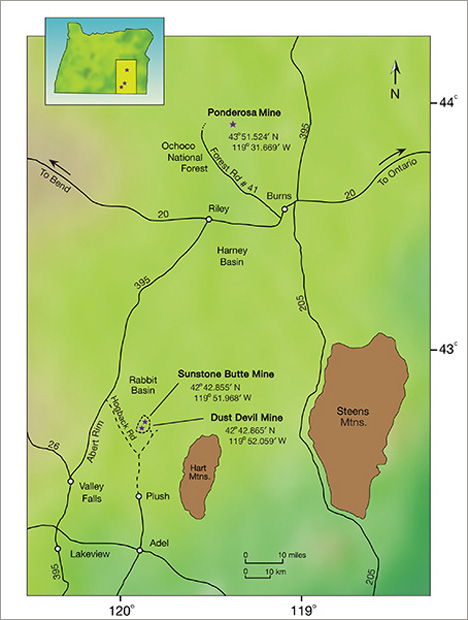
Illustration by Larry Lavitt.
Geologic Context
In eastern Oregon, sunstone occurs as phenocrysts in highly porphyritic basalt flows (see figure 4). They are a minor but fascinating part of the region’s recent geologic history, likely originating during an episode of widespread basaltic volcanism that occurred 15–17 million years ago (Ma), during the Miocene epoch. Geologists debate whether the volcanic events were caused by melting of subducted oceanic crust or by a hot plume in the earth’s mantle. The Steens Basalt of the Oregon Plateau (figure 5), where volcanic flow deposits can contain up to 50% large feldspar crystals (Walker, 1979), erupted around the same time as the more extensive Columbia River basalts further north. 40Ar/39Ar dating indicates the eruptions took place between 15.51 +/- 0.28 Ma and 16.59 +/- 0.10 Ma (Brueseke et al., 2007).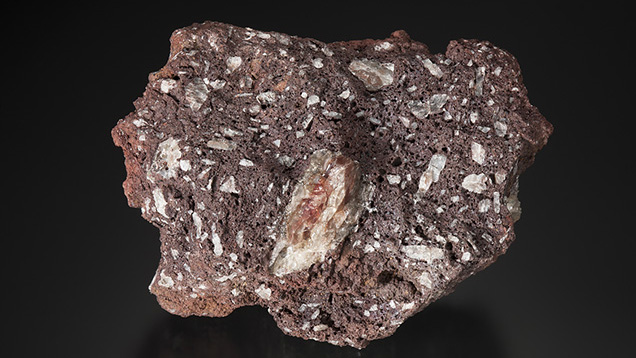
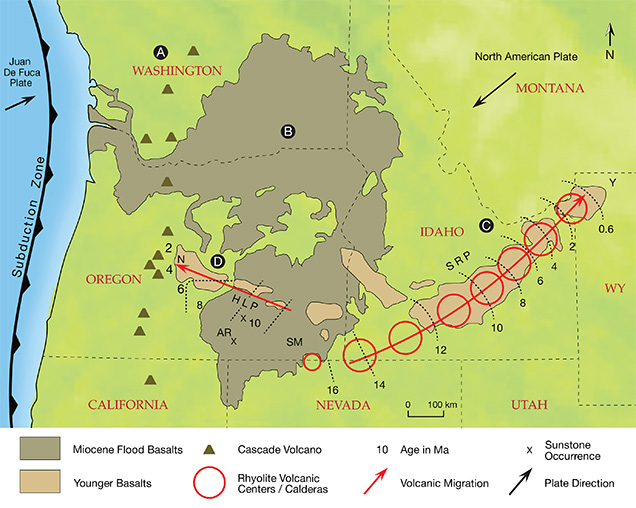
According to Stewart (1966), the sunstone lavas within the Rabbit Basin are petrographically similar to plagioclase-rich flows within the Steens Basalt. They are also strikingly similar to lava flows exposed at the Abert Rim, a spectacular fault scarp some 760 meters (2,490 feet) high, located 10–15 miles southwest of the Rabbit Basin sunstone localities. Gunn and Watkins (1970) proposed that these lavas are part of the same volcanic episode, and that their feldspar phenocrysts might even have originated in the same magma chamber. In a future visit, we aim to collect representative samples from plagioclase-rich flows at Abert Rim and Steens Mountain and compare them with material from each of the three mines to see if we can confirm their relationships.
Feldspar phenocrysts that formed before eruption are surrounded by a finer-grained or glassy groundmass of the lava flow. Also contained in such groundmasses are smaller labradorite phenocrysts (An60), usually just a few millimeters in size, that crystallized in the flow as it cooled. Stewart’s analysis (1966) gave a composition of An67.2/Ab31.5/Or1.3 for the larger feldspar phenocrysts and An60 for the smaller labradorite phenocrysts in the groundmass. We intend to perform Ar-Ar dating on samples of basalt and feldspar phenocrysts from all three mine locations to determine their relative ages.
The feldspar must have formed over time within a magma chamber of calcium-rich magma that cooled slowly, allowing it to reach considerable size. Stewart (1966) proposed that primary crystallization occurred at depth under relatively uniform conditions of about 1100°C. He cited a large lath-shaped crystal measuring 8.3 × 2.6 × 0.8 cm. This is a substantial crystal by most standards, but we found larger, blockier ones at the Sunstone Butte mine. This might be because the crystals at Sunstone Butte cooled more slowly in a larger body of rock—within a cinder cone—and were not extruded in thinner lava flows, as elsewhere in the Rabbit Basin. As a result, there appears to be less fracturing due to thermal and mechanical shock, and intact crystals are recovered more frequently.
Ponderosa Mine
The road to the Ponderosa mine gains in elevation as the scenery gradually changes from meadows to thick stands of tall ponderosa pines. It is classic volcanic highland, littered with cinder cones, extensive basalt flows, ashfall tuffs, and red cinder beds.A map drawn by John Woodmark, Ponderosa’s owner and the president of Desert Sun Mining & Gem Co., led us to the mine, where we stayed in a bunkhouse. Woodmark purchased the property in 2003. For earlier history of the Ponderosa mine, see Johnston (1991) and Sinkankas (1997).
The mine is located at an elevation of 1,753 meters (5,700 feet) on the southwest side of Donnelly Butte. The mining season runs from June to October, when the mine is free of snow. Because Woodmark owns the property, it is not subject to regulation from the Bureau of Land Management or other government agencies.
The mine site covers some 60 acres (just over 24 hectares). Although only one-fourth of an acre has been mined to a depth of 6 meters (20 feet), Woodmark said that sunstone occurs throughout the property.
Johnston (1991) reported on the Ponderosa mine and its gem materials, characterizing the labradorite as 70% anorthite and 30% albite, placing it at the labradorite/bytownite boundary.
The sunstone occurs in a localized, weathered basalt flow (figure 6). So far, this is the only one of four basalt flows examined at the site that contains sunstone. The basalt being mined is moderately to heavily weathered, reduced to reddish brown soil containing nuggets of harder basalt in sections of the pit. Currently, Woodmark is recovering higher than normal quantities of red to pink rough from a section of the pit—approximately 20% of the sunstone mined. In 2010, his estimated recovery rate of red to pink rough was around 2–4%.
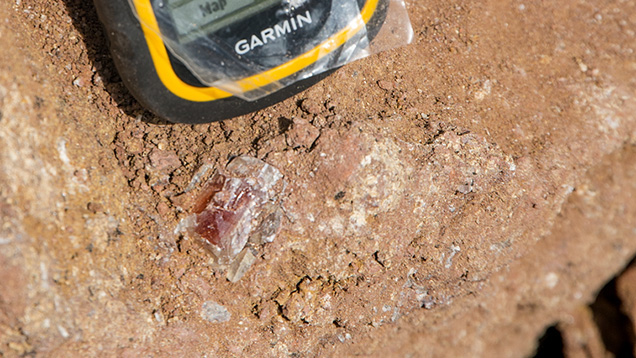
Ponderosa produces 1 million carats of rough per year (figures 7–9) over the course of approximately 20 days (in three or four increments). Woodmark estimates he could mine 4–6 million carats per year, given sufficient demand. Currently there are only a handful of people to drive the loaders and operate and maintain the other equipment. The mine also employs Native American teenagers from the nearby reservation. Woodmark pays the pickers $10 per kilogram of concentrate recovered. Each picker averages 1 kg per hour.
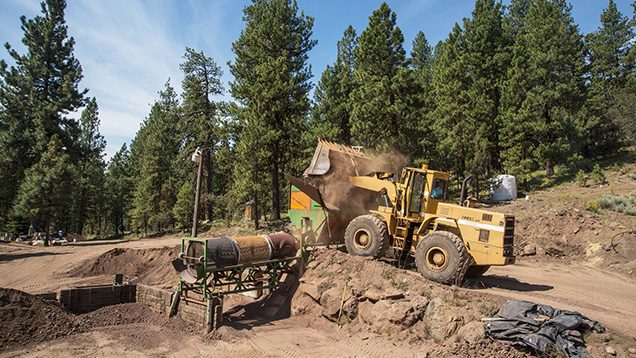
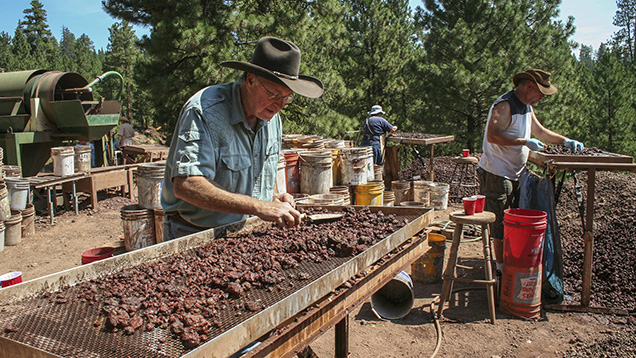
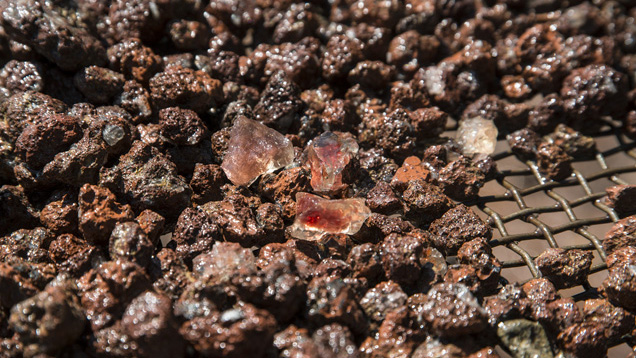
Woodmark stockpiles the colorless and yellow material because it is so easily treatable (Emmett and Douthit, 2009), and he is concerned it could harm the market for untreated Oregon sunstone. Woodmark is considering bead production as a source of revenue from this clear to champagne-colored rough.
Dust Devil Mine
The Rabbit Basin lies three hours south of Burns, through a desolately beautiful landscape of alkaline lakes, sand dunes, and volcanic ridges. Alt and Hyndman (1978) provide a brief summary of the roadside geology. At Hogback Road, the paved surface ends and 35 miles of gravel road begins, leading eventually to the Dust Devil mine.Travel trailers punctuate the desert, marking the sites where miners are working claims. At 1,402 meters (4,600 feet), this is high desert country dotted with sagebrush. No permanent structures are permitted by the Bureau of Land Management, and mining activities are subject to strict environmental regulations. As with the Ponderosa mine, the weather dictates the mining season, which runs from mid-May to mid-October, when the first snows typically fall.
The sunstone-bearing basalts cover about seven square miles (18 km2) at the northern end of the basin. They are a sequence of gray to strong reddish brown vesicular flows that form low rounded hills, reaching their highest point at Dudeck Ridge. The flows are typically only 3–6 meters (10–20 feet) thick, narrowing considerably toward the edges. The bedrock beneath the sunstone basalts is a gray-brown ashflow tuff of variable thickness. Underneath the tuff lies a vesicular black basalt (Peterson, 1972).
According to Don Buford, co-owner of the Dust Devil mine, thin flows cool rapidly, exerting pressure on crystals as they contract and causing extensive fracturing. Thicker flows cool more slowly, exerting less stress on the crystals and allowing them to retain their size. Phenocryst fracturing may also be due to movement and mechanical contact between crystals within the lava flow during emplacement (Peterson, 1972).
Buford and co-owner Terry Clarke (figure 10) have been very active in marketing untreated Oregon sunstone. Gems from Dust Devil have been used by notable artists such as Dalan Hargrave, Will Cox, Larry Winn, Larry Woods, Krista McMillan, and John Dyer to garner more than 15 American Gem Trade Association (AGTA) Cutting Edge awards. A pit operation with a modern separation plant (figures 11–14), the mine is known for its variety of stone colors and sizes up to 1,093 ct—nearly as large as a tennis ball.
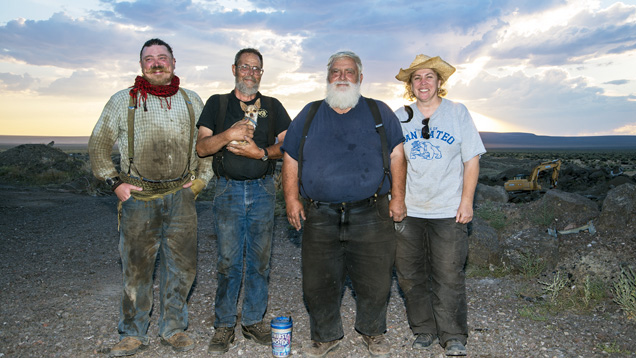
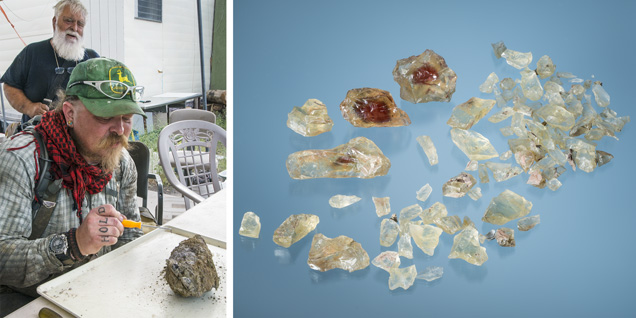
- 86.64 ct (3.5 × 3.3 × 1.7 cm): pale yellow rim with an orange-red core
- 110.99 ct (5.8 × 1.7 × 1.3 cm): pale yellow rim with an orange-red core and a touch of green on the periphery
- 101.63 ct (4.0 × 2.2 × 1.4 cm): orange-red core with intense schiller and a narrow green periphery
- The remaining pieces were pale yellow: one 45.29 ct specimen, three totaling 100.49 carats, four totaling 80.89 carats, and a bag of assorted yellow shards totaling 315.81 carats.
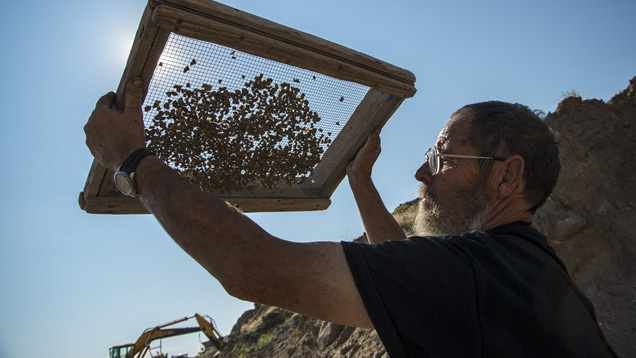
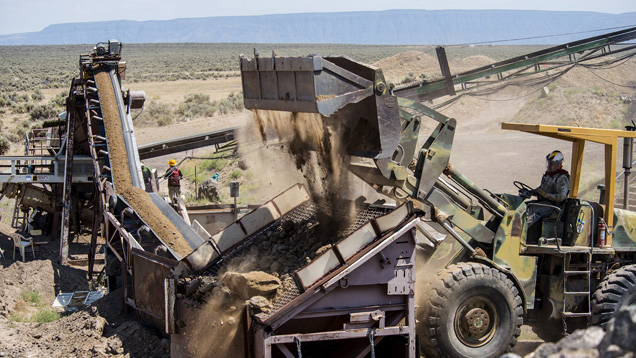
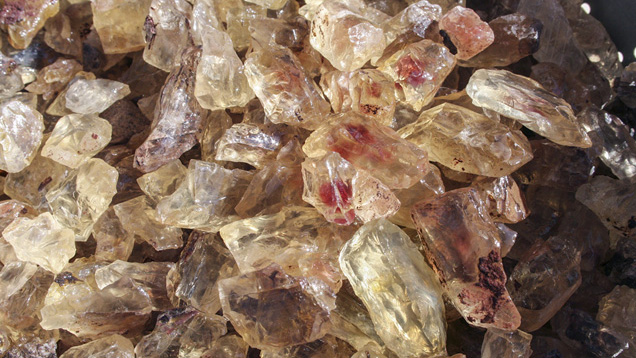
Most crystals are fractured and therefore difficult to recover intact. Pough (1983) drew a correlation between sunstone’s color distribution and its conchoidal fractures: Red and green colors—along with schiller—tend to be limited to the cores of phenocrysts, rarely reaching fracture surfaces (again, see figure 11, right).
We plan to investigate whether copper can be leached from crystals after emplacement by a secondary process. The example shown in figure 11 would be ideal for chemical analysis, as we know that all its fragments came from a single crystal.
Sunstone Butte Mine
A new deposit, Sunstone Butte (figure 15), has become known among boutique jewelry designers since 2011 for its large green, red, and bicolor gems. According to mine owners Dave Wheatley and Tammy Moreau, 45–50% of the gem-bearing “ore” is volcanic cinder as opposed to the basalt flows at the other Rabbit Basin mines. They told us that the most notable aspects of the mine’s production are the size of the crystals and their green colors. Crystals often reach 100 ct, and sometimes up to 500 ct (figure 16). About 75% of the sunstones have green coloration, many with bluish green “teal” hues.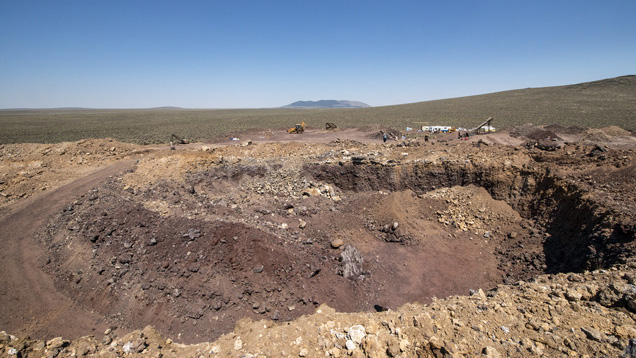
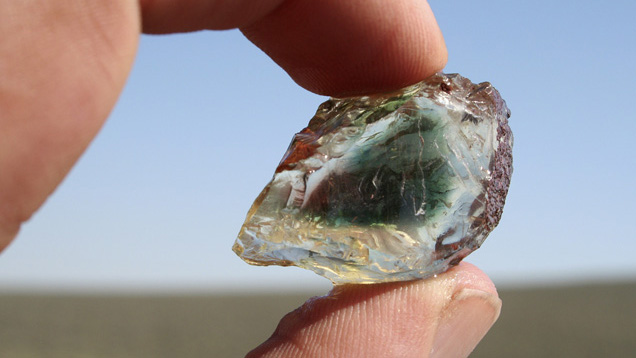
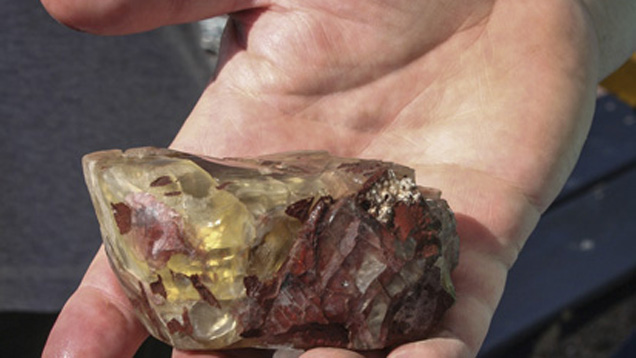
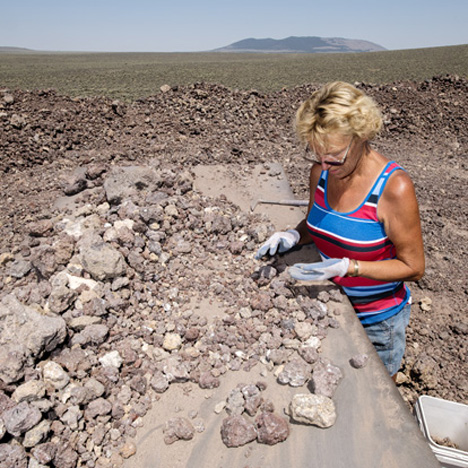
matrix with a small hammer to release feldspar phenocrysts. Photo by Robert Weldon.
